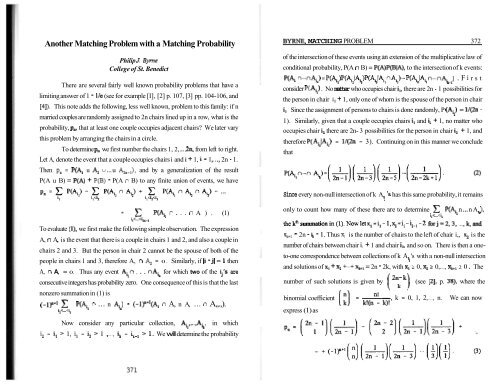Vol. 10 No 5 - Pi Mu Epsilon
Vol. 10 No 5 - Pi Mu Epsilon
Vol. 10 No 5 - Pi Mu Epsilon
Create successful ePaper yourself
Turn your PDF publications into a flip-book with our unique Google optimized e-Paper software.
Another Matching Problem with a Matching ProbabilityPhilip J. BymeCollege of St. BenedictThere are several fairly well known probability problems that have alimiting answer of 1 - 11e (see for example [I], [2] p. <strong>10</strong>7, [3] pp. <strong>10</strong>4-<strong>10</strong>6, and[4]). This note adds the following, less well known, problem to this family: if nmarried couples are randomly assigned to 2n chairs lined up in a row, what is theprobability, p, that at least one couple occupies adjacent chairs? We later varythis problem by arranging the chairs in a circle.To determine pro we first number the chairs 1, 2,. .. ,2n, from left to right.Let A, denote the event that a couple occupies chairs i and i + 1, i = 1 ,. . ., 2n - 1.Then p,, = P(A, u 4 u ... u A^,.,), and by a generalization of the resultP(A u B) = P(A) + P(B) - P(A P B) to any finite union of events, we have+ P(Ai r- . . . n A ) . (1)il 1 , ..., ik -in which> 1. We will determine the probabilityBYRNE, MATCHING PROBLEM 372of the intersection of these events using an extension of the multiplicative law ofconditional probability, P(A n B) = P(A)P(BlA), to the intersection of k events:P(Ai n...nAi) = P(Ai)P(Ai2lAi)P(AJA,nAi).-P(AklAil n-.nA4-) . F i r s tconsider P( Ai) . <strong>No</strong> matter who occupies chair in there are 2n - 1 possibilities forthe person in chair ii + 1, only one of whom is the spouse of the person in chairi,. Since the assignment of persons to chairs is done randomly, P (Ai) = lf(2n -1). Similarly, given that a couple occupies chairs i, and i, + 1, no matter whooccupies chair i2 there are 2n- 3 possibilities for the person in chair i2 + 1, andtherefore P(A41Ai) = ll(2n - 3). Continuing on in this manner we concludethatSince every non-null intersection of k A. 's has this same probability, it remains'1only to count how many of these there are to determine E P(A, n ... n A. ),'ki,< ...
















